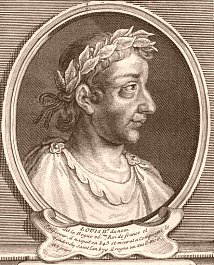Louis III (863/65 – 5 August 882) was the king of West Francia from 879 until his death in 882. The eldest son of king Louis the Stammerer and his first wife Ansgarde of Burgundy, he succeeded his father and ruled jointly with his younger brother Carloman II, who became sole ruler after Louis's death. Louis's short reign was marked by military success.
 |
| Louis III |
Louis was born while his father was King of Aquitaine and his grandfather Charles the Bald was ruling West Francia. Some doubts were raised about his legitimacy, since his parents had married secretly and Ansgarde was later repudiated at Charles' insistence.
When Charles died in 877 and then Louis the Stammerer died two years later, some Frankish nobles advocated electing Louis as the sole king, but another party favoured each brother ruling a separate part of the kingdom. In September 879 Louis was crowned at Ferrières Abbey.
In March 880 at Amiens the brothers divided their father's kingdom, Louis receiving the northern part, called Neustria or sometimes simply Francia. Duke Boso, one of Charles the Bald's most trusted lieutenants renounced his allegiance to both brothers and was elected King of Provence.
 |
| Louis III |
In the summer of 880 Carloman II and Louis III marched against him and captured Mâcon and the northern part of Boso's kingdom. They united their forces with those of their cousin Charles the Fat, then ruling East Francia and Kingdom of Italy, and unsuccessfully besieged Vienne from August to November.
In 881 Louis III achieved a momentous victory against Viking riders, whose invasions had been ongoing since his grandfather's reign, at the Battle of Saucourt-en-Vimeu. Within a year of the battle an anonymous poet celebrated it and the king, for both his prowess and piety in a short poem Ludwigslied composed in the Old High German.
Louis III died on 5 August 882 at Saint-Denis in the centre of his realm, having hit his head and fallen from his horse while chasing a girl with amorous intent. He hit the lintel of a door with his head while mounting his horse and fractured his cranium on impact, which led to his death. Since he had no children, his brother Carloman II became the sole king of West Francia and the victor of Saucourt was buried in the royal mausoleum of the Basilica of St Denis.
LOUIS IV
Louis IV (September 920 / September 921 – 10 September 954), called d'Outremer or Transmarinus (both meaning "from overseas"), reigned as king of West Francia from 936 to 954.
 |
| Louis IV |
His reign is mostly known thanks to the Annals of Flodoard and the later Historiae of Richerus. The only child of king Charles the Simple and his second wife Eadgifu of Wessex, Louis was born in the heartlands of West Francia's Carolingian lands between Laon and Reims in 920 or 921. From his father's first marriage with Frederuna (d. 917) he had six half-sisters and was the only male heir to the throne.After the dethronement and capture of Charles the Simple in 923, queen Eadgifu and her infant son took refuge in Wessex (for this he received the nickname of d'Outremer) at the court of her father King Edward, and after Edward's death, of her brother King Æthelstan. Young Louis was raised in the Anglo-Saxon court until his teens. During this time he enjoyed legendary stories about Edmund the Martyr, King of East Anglia, an ancestor of his maternal family who had heroically fought against the Vikings.
 |
| Louis IV |
Louis became the heir to the western branch of the Carolingian dynasty after the death of his captive father in 929, and in 936 was recalled from Wessex by the powerful Hugh the Great, Margrave of Neustria, to succeed the Robertian king Rudolph who had died. Once he took the throne, Louis wanted to free himself from the tutelage of Hugh the Great, who, with his title of Duke of the Franks was the second most powerful man after the King.
In 939 the young monarch attempted to conquer Lotharingia; however, the expedition was a failure and his brother-in-law, king Otto I of East Francia counterattacked and besieged the city of Reims in 940. In 945, following the death of William I Longsword, Duke of Normandy, Louis tried to conquer his lands, but was kidnapped by the men of Hugh the Great. The Synod of Ingelheim in 948 allowed the excommunication of Hugh the Great and released Louis from his long tutelage. From 950 Louis gradually imposed his rule in the northeast of the kingdom, building many alliances (especially with the Counts of Vermandois) and under the protection of the Ottonian kingdom of East Francia.










